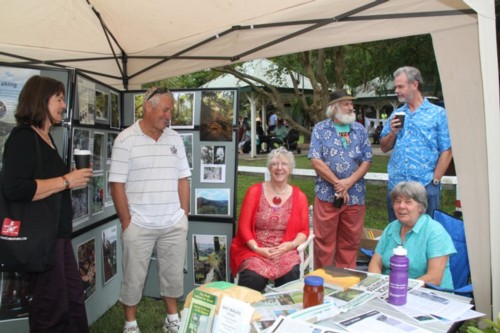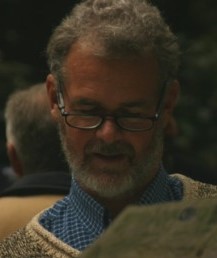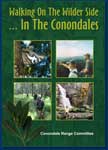Remembering Mark
He left his Mark on the Conondales… and on us.
 We pay tribute to long-time friend, and friend of the Conondales, Mark Ricketts
We pay tribute to long-time friend, and friend of the Conondales, Mark Ricketts
When Mark Ricketts died suddenly and unexpectedly in Maleny hospital on Good Friday, it sent out a wave of both disbelief and grief that spread well beyond environment circles on the Sunshine Coast.
Mark became involved with the Conondale Range Committee about twenty-six years ago when he attended an AGM in Maleny. He knew the Conondales; he’d bought land near Reesville, just outside Maleny, near the eastern headwaters of the Mary, and overlooking the Conondales.
Long-term CRC members will remember the major battles through the seventies and early eighties to save the magnificent forests of the Conondales from being logged for the establishment of plantations. There had been a number of calls for a National Park to save key parts, but they’d fallen on deaf ears and, in the early eighties when the Funnel’s Hut Road had been pushed through, it looked like the battle was all but lost.
Enter Mark Ricketts, feeling he should become involved, especially as there was talk of an open cut gold mine right in the very same area.
Mark often recalled that when he was elected vice-president, he wasn’t too concerned as there’d be a president making all the moves. Little did he realise that the very egalitarian CRC had several vice presidents but intentionally, at that time, no president.
Mark breathed life into the embers of a conservation group that had battled long and hard. The CRC had been the first group to put its hand in its collective pockets to employ a full-time project officer, Richard Giles. It was a totally different era, with Joh Bjelke-Petersen at the helm, where good environmental logic was something all too readily bulldozed aside.
Just as Mark brought new energy to the campaign, so did the arrival of several new members from Kenilworth… people like Rowley and Chris Drysdale, Elli Schlunke and Cheryl Seabrook and the CRC, which had been more or less based in Nambour, then Maleny, took on a more Kenilworthian base.
They battled not only forestry issues but also the expanding Agricola gold mine. A major turning point for Mark in his burgeoning environmental activism was when, at a meeting with high-level forestry staff in Brisbane, there was a clunking sound that suddenly emanated from behind a pile of books midway through the meeting. Mark realised the whole thing was being taped and that the cassette had just run out. It was a pivotal moment where he realised that “they” were more worried about “us” than we’d ever realised.
As for the goldmine, Mark recalled at our first National Park celebration back in 1991, that it actually brought us “greenies” and foresters much closer together, both at least having a passion for forests, compared to the miners who simply saw them as something standing between them and an ore body, and to be removed as expediently as possible.
Mark often told of his ‘contact’ inside Forestry whom he’d dubbed “Deep Throat”, who’d call up in the middle of the night and suggest appropriate timing and matters to be brought up with the minister. Being public servants, Forestry staff couldn’t speak out but were clearly opposed to the mine. Mark always had his suspicions as to the identity of “Deep Throat” and finally had it confirmed a decade or so back.
All these battles are now back in the mists of time. The gold mine encountered major geological problems preventing further expansion but only after a small fortune had been expended building an on-site treatment plant. A plan was mooted to truck in ore from all around southeast Queensland, haul it up the narrow, winding forestry roads to the Agricola plant for cyanide treatment.
The Kenilworth community rose up in opposition. Some even questioned the safety of hauling cyanide up those same narrow winding roads, when, lo and behold, half a dozen cyanide drums rolled off a truck taking a back road up through Yednia and two burst open.
The white suited clean-up made page one of the Courier Mail with a few even suggesting the CRC had bribed the driver. As the trucking plan involved forestry roads, it required cabinet approval and after intense campaigning it was knocked back. The following year the company, Astrik Resources, filed for bankruptcy, walking away from any clean-up operation. The only money held toward it had been $15 000 gleaned as a bond by Forestry for anticipated roadworks.
The tide was turning for the Conondales and good environmental outcomes, but much more lay ahead.
CRC meetings became convivial curry nights held in houses around Kenilworth or Maleny. Mark postulated that curries were a key ingredient in the longevity of an environment group and it’s hard to refute the evidence. It was more than curry though, it was a unique blend of quick wit, a great sense of often irreverent humour and an ability for lateral and incisive decision-making that made this section of the CRC’s long history an effective one.
Somewhere during this time, Mark followed the time-honoured path of entering environmental campaigning through a local issue only to become more involved on a wider stage. He became the project officer with SCEC and was involved in a number of successful campaigns there. Others can tell the details of that involvement and how it changed the trajectory of the Sunshine Coast’s development away from being a carbon copy of the Gold Coast.
Mark may have worked at SCEC, but his heart was still in the Conondales and he still yearned for a more secure future for its native forests.
When the Goss government swept into power, it had pledged an expanded National Park in the Conondales and it was here that Mark came into his own as a skilled negotiator. Rather than wait for bureaucrats to draw new lines on a map, Mark had been inspired by the Salamanca Agreement in Tasmania and successfully persuaded high-ranking forestry staff to initiate a ground-breaking consultative process for the Conondales, one that involved forestry, national parks, timber industry and conservationists. At its heart were detailed on-ground scientific studies, with final decisions to be based on sound science.
We celebrated that expanded Conondale National park at a special weekend event back in 1991. It was wonderful to meet up with many of the earlier campaigners who readily admitted they’d despaired of ever seeing it come about. In our midst, was Ross Scott, the Kenilworth scoutmaster who’d made the first call for a National Park back in 1966.

Stories were told into the night, of the huge fallen bunya, of how the letter “e” had been the spark behind the paired catchment study that had ultimately saved the old-growth forests of Bundaroo, and of course, curries were consumed.
Mark’s skills had become apparent to some in the new government and he’d been enticed into becoming a bureaucrat himself, working in Brisbane in Pat Comben’s Department of Environment and Heritage, and with his long-time friend Ian Christesen. The long daily commute from Reesville to Landsborough and thence train to the metropolis was incredibly wearing but Mark used laptop to good advantage on the train ride.
We still had CRC meetings and nights of curry. Mark had the distinction of being able to apparently fall asleep in mid–conversation, and rejoin it on awakening, without missing a beat. Similarly his affiliations with SCEC managed to be fitted into his incredibly hectic life.
Somewhere in here, he drew a line under his time of writing pollution legislation with DEH and made the leap of being Jim Soorley’s environment advisor on Brisbane City Council.
It was at this time, and after year’s of CRC agitating (many curries, many letters) for a rehabilitation of the Agricola mine that Mark and I managed a meeting with the Mines Minister Tony McGrady. All prepared to be at our persuasive best, we were floored when the minister announced a clean-up budget and introduced us to Rob Savory, the man charged with masterminding the whole process, again an inclusive one that would become known as the Agricola Consultative process. Sound familiar? Rob Savory told us later it was the shortest meeting the minister had ever had.
While the Conondale National Park had been expanded by the earlier process, the Regional Forest Agreement had the potential to deliver an even better outcome. Aila Keto did wonderful work towards this, but it wasn’t all plain sailing with some sections of the Labor Party. At one point, when the AWU faction looked like opposing Aila’s position, we held a memorable CRC meeting at Mark and Elaine’s place at Reesville.
Under the influence of curry and red wine, Mark went rather lateral and decided to mock up a media release that the Labor Party was in favour of logging old growth forest and that a national campaign was mooted involving even Peter Garrett (at that stage politically non-aligned). The release only went out to state ALP politicians although they presumably were under the impression it had gone media-wide.
Nothing happened for a couple of days, then Cheryl had a call from Jim Elder’s office (Jim Elder, at the time being the Deputy Premier, who would later fall on his sword over vote rorting). Cheryl had none of her normal confident composure when she informed us that he didn’t ring to arrange a meeting, he wanted instead to sue us.
The response of the ever-unflappable Mark Ricketts… to contact long-time friend, solicitor and ex-Labor member for Noosa, Ray Barber. “Hello Ray,” says Mark, “Long time no sue.”
It was a tense meeting when Mark and I did meet with Jim Elder at the community cabinet meeting in Maleny but he never did keep to his threat.
What really took the heat out of the whole RFA debate in southeast Queensland was the government’s decision to buy out the Boral mill at Cooroy. This totally lateral solution has all the hallmarks of having come from Mark but I never did confirm this.
Somewhere way back, the CRC had apparently fatigued of explaining its “no president” arrangement and had decided to have one and made me it. Throughout, Mark remained a vice-president, apart from when he and Elaine announced their defection to Samoa for 3 years. It was then that we appointed them CRC Cultural Attaches to the South Pacific.
Mark was out of the country for much of the Traveston Dam campaign but still gave wise counsel by email and was a key part of the memorable “council of war” at SCEC only days out from a decision by Peter Garrett.
But all this recognition and chronicling of achievements doesn’t even begin to touch the sides of why Mark was special to so many. Very capable and effective in his own right, he had a way of quietly ensuring that others found these same skills in themselves, yet never in quite the same unique package that was Mark.
The full story of Mark Ricketts will never be told by any one person, it can only be grasped as a diversely rich and colourful mosaic told by all those whose life paths were privileged to have crossed with his.
For that reason, a special celebration of Mark’s life, his warm humanity and his understated achievements, will be held at the Old Witta School on Saturday May 14. While there is a request to be adorned in colourful shirts and clothing, there can be no hiding the fact that one beautifully unique mix of colour and humanity has gone from the fabric of our lives.
Ian Mackay April 2011




